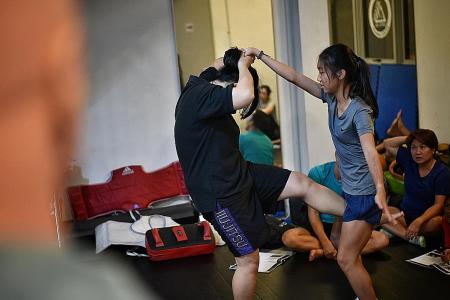Molest victims aren't just speaking up, they are fighting back
Police figures show more women are reporting outrage of modesty but that is not the only way women are getting back at their attackers
When Nora (not her real name) fell asleep on her usual bus ride in September, a man sat with her.
She woke up to find him touching her chest. She was so shocked, she could not react to being violated.
Not only did the man not try to escape, he had the audacity to remain seated next to her and even offered her a sweet.
The number of reported outrage of modesty cases has been increasing.
Between January and June, there were 832 reported cases, an increase of 147 cases compared with the same period last year. Of the 832 cases, 105 happened on public transport, which was an increase of 43.8 per cent, or 32 cases.
Nora, 20, a data administrator, told The New Paper that the mancontinued harassing her - asking where she was heading and if she had a boyfriend, but she kept silent.
He stopped only after she pretended to call someone, and alighted at the next stop.
Molest victims are never the same after such attacks.
Nora, who took that bus service every Friday, no longer sees commuting as a leisurely pastime. She said: "I never had a problem with going out alone and never felt unsafe, but (when that incident happened) I felt I was in danger.
"I was quite scared.I never expected it to happen to me."
To combat this, in August, the Singapore Police Force launched a pilot run of volunteer patrols at MRT stations by Queenstown's Mei Ling Zone Residential Committee to deter molesters.
The volunteers - who work in groups of seven - are from the community programme Citizens on Patrol (COP).
They help the police look out for suspicious behaviour at train stations and hand out crime prevention pamphlets to raise awareness of outrage of modesty cases on public transport.
The police plan to involve more than 700 COP groups islandwide to patrol MRT stations once a month.
Public entertainment outlets also saw a rise in outrage of modesty cases, with an increase of 17 cases - a 37 per cent rise.
In August, 12 men, aged between 22 and 59, were charged in court over two days for 12 separate outrage of modesty cases between January 2017 and July this year.
LONG-TERM IMPACT
Stella, (not her real name), 28, a regional enterprise sales manager at a software company, was molested on the train six years ago, and she also encountered a flasher at Hougang MRT station a decade ago.
Now, she gets paranoid when a stranger enters the same lift as her. She told TNP: "If someone entered the lift and behaved strangely, I would think he was a flasher."
There has been a spate of molest and upskirt cases reported recently, including an incident where a National University of Singapore student was caught after allegedly molesting a woman at Serangoon MRT station.
Under Section 354(1) of the Penal Code, outrage of modesty is defined as assault or use of criminal force to any person with intent to outrage the modesty of that person.
Mr James Ow Yong, senior associate at Kalco Law, said this includes inappropriate touching, pressing and pinching.
Mr Ow Yong said fleeting touches tend to occur at the spur of the moment.
He added: "This can coincide with impulse control disorders, on the contrary to intricately planned and predatory acts."
DON'T BLAME VICTIM
With movements such as #MeToo and more recently, #WhyIDidntReport with victims explaining why they kept mum about their experiences, more victims have spoken up.
But there are still many sceptics who not only doubt the credibility of victims' stories but even put the blame on them.
Nora, who follows the online conversations on Twitter, said some netizens blame women for dressing provocatively or going out alone at night.
She said: "I am an example that this cannot be true because I wear a hijab and I was on a bus in broad daylight.
"The blame should not be placed on what women wear but rather what men do."
A psychiatrist pointed out that women are still seen as the weaker sex and men think they can bully women and get away with it.
However, he added that while a victim should never be blamed, it is still important to take precautions such as avoiding dangerous areas at night.
Ms Anisha Joseph, head of the Sexual Assault Care Centre of the Association of Women for Action and Research (Aware), said if the attack happened in a public place, a victim's next option depends on her comfort level.
Options include speaking to a bystander, alerting the staff if it occurred on a train or bus, or simply moving away from the perpetrator.
Nora, who did not make a police report, said that she wished she had done so to prevent her attacker from striking again.
DEFENDING THEMSELVES
Women are not only speaking up, they are actively taking steps to empower themselves - with self-defence classes.
Stella has been taking self-defence classes at Kapap Academy since September, as she wants to be prepared if she is ever molested again.
She said: "The instructors always emphasise that if anything happens to you, it is going to take a long time to forget it."
Madam Emily Tan, 47, takes self-defence classes at Kapap Academy with her two teenage daughters and husband.
The admin manager's older daughter takes the train to and from school, and both daughters take a 15-minute walk home.
Kapap Academy taught Madam Tan the ways that molesters can attack. And knowing that her daughters can defend themselves against molesters has put her more at ease.
Madam Tan said: "We cannot pick them up all the time, so we expect them to know some form of self-defence."
Get The New Paper on your phone with the free TNP app. Download from the Apple App Store or Google Play Store now



